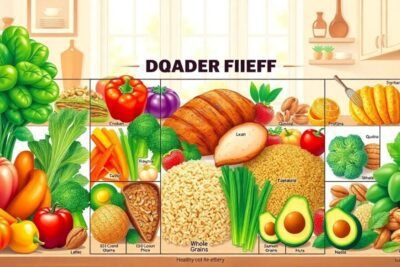
How to reverse diabetes diet: a guide to healthier living
Diabetes is a growing health concern worldwide, particularly type 2 diabetes. Understanding how to reverse diabetes through diet can significantly impact your health and well-being. This article delves into effective strategies to manage and potentially reverse diabetes through dietary and lifestyle changes.
- What is a diabetes diet and how does it work?
- How to create a healthy eating plan for diabetes?
- What foods do I need to include in my diabetes diet?
- How much weight do you need to lose to reverse type 2 diabetes?
- Can a low-calorie diet help with diabetes remission?
- What are the benefits of a healthy lifestyle for diabetics?
- How to monitor your blood sugar levels effectively?
- Related questions about diabetes management
What is a diabetes diet and how does it work?
A diabetes diet focuses on healthy, nutrient-dense foods that help manage blood sugar levels. The primary goal is to maintain stable glucose levels while providing the body with essential nutrients. By choosing the right foods, individuals can significantly improve their diabetes management.
The diet emphasizes the intake of fruits, vegetables, whole grains, and lean proteins while minimizing processed foods and added sugars. This approach not only supports blood sugar control but also aids in weight management, which is crucial for those looking to reverse diabetes.
Moreover, understanding carbohydrates is vital. Foods that are high in fiber can help slow down the absorption of sugar, preventing spikes in blood glucose levels. Incorporating healthy fats, such as omega-3 fatty acids, is also beneficial.
How to create a healthy eating plan for diabetes?
Creating a healthy eating plan for diabetes involves careful consideration of food choices and portion sizes. Here are some steps to consider:
- Consult with a healthcare provider or a registered dietitian to tailor a plan to your specific needs.
- Focus on whole, unprocessed foods that provide nutrients without excess calories.
- Incorporate a variety of food groups to ensure balanced nutrition.
- Monitor your blood sugar levels regularly to understand how different foods affect you.
Another effective method is the plate method, where half of your plate consists of non-starchy vegetables, one-quarter protein, and one-quarter whole grains. This visual approach simplifies meal planning and helps control portions.
What foods do I need to include in my diabetes diet?
Incorporating specific foods into your diet can significantly impact your diabetes management. Essential foods include:
- Leafy greens: Spinach, kale, and other greens are low in calories and carbohydrates.
- Whole grains: Brown rice, quinoa, and whole wheat bread provide fiber and nutrients.
- Lean proteins: Chicken, turkey, fish, and plant-based proteins like beans can help maintain muscle mass.
- Nuts and seeds: Almonds, walnuts, and chia seeds are great sources of healthy fats.
- Berries and citrus fruits: These fruits are rich in vitamins and antioxidants, helping to control blood sugar levels.
In addition to these foods, it is crucial to avoid added sugars, refined carbohydrates, and high-fat processed meats. Adopting healthy eating tips for diabetes management can foster a sustainable diet that supports overall health.
How much weight do you need to lose to reverse type 2 diabetes?
Losing as little as 5-7% of your body weight can have a significant impact on reversing type 2 diabetes. This weight loss is linked to improved insulin sensitivity and better blood sugar control. For example, if you weigh 200 pounds, losing just 10-14 pounds can help.
Research shows that weight loss can lead to remission in many individuals with type 2 diabetes. However, it is essential to approach weight loss sustainably through diet and exercise rather than extreme measures.
Regular physical activity in combination with a healthy diet can enhance weight loss efforts. Engaging in moderate exercise at least 150 minutes per week is typically recommended.
Can a low-calorie diet help with diabetes remission?
A low-calorie diet can be effective for some individuals in achieving diabetes remission. Studies indicate that calorie restriction can lead to significant weight loss and improved metabolic health. However, it is crucial to ensure that the diet remains balanced and nutrient-rich.
Such diets often involve reducing caloric intake while maintaining essential nutrients, focusing on high-fiber foods that provide volume without excess calories. It is advisable to consult with a healthcare provider before making drastic dietary changes.
Implementing a structured meal plan can help individuals adhere to low-calorie diets while ensuring they get the necessary vitamins and minerals.
What are the benefits of a healthy lifestyle for diabetics?
Adopting a healthy lifestyle has numerous benefits for individuals with diabetes. Key advantages include:
- Improved blood sugar control: Regular physical activity and a balanced diet can help stabilize glucose levels.
- Weight management: Maintaining a healthy weight reduces the risk of diabetes complications.
- Reduced risk of cardiovascular diseases: Healthy eating and exercise improve heart health, which is crucial for diabetics.
- Enhanced mental health: Regular physical activity has been linked to improved mood and reduced stress.
Incorporating lifestyle changes, such as increased physical activity and dietary modifications, can empower individuals to take control of their health and prevent complications associated with diabetes.
How to monitor your blood sugar levels effectively?
Monitoring your blood sugar levels is a vital part of diabetes management. Understanding how to do this effectively can help prevent complications. Here are some tips:
First, consistently check your blood sugar levels at home using a glucose meter. This allows you to track how certain foods and activities affect your glucose levels. Keeping a log of your readings can help identify patterns.
Second, work with your healthcare provider to determine a target range for your blood sugar levels. Regular follow-ups can help adjust your management plan as needed.
Lastly, consider continuous glucose monitoring systems (CGMs), which provide real-time data on your glucose levels throughout the day. These devices can be particularly helpful for individuals who experience significant fluctuations in their blood sugar.
What foods do I eat to reverse diabetes?
To reverse diabetes, focus on a diet rich in whole foods. Incorporate high-fiber vegetables, whole grains, lean proteins, and healthy fats. Avoid refined sugars and processed foods. Foods like beans, legumes, nuts, and seeds can also help maintain stable blood sugar levels.
Is it possible to reverse diabetes with diet?
Yes, it is possible to reverse diabetes with diet. Many studies indicate that adopting a healthy eating plan and losing weight can lead to significant improvements in blood sugar control and, in some cases, remission of type 2 diabetes. These dietary changes, combined with regular physical activity, can yield lasting results.
What is the fastest way to reverse diabetes?
The fastest way to reverse diabetes involves a combination of dietary changes, weight loss, and increased physical activity. Implementing a low-calorie, nutrient-rich diet along with regular exercise can lead to rapid improvements. However, always consult with a healthcare professional before making drastic changes to your routine.
How do you flush out diabetes?
Flushing out diabetes involves optimizing your diet to eliminate processed foods and sugars while increasing water intake and fiber-rich foods. Consuming foods that regulate blood sugar levels can help ‘flush out’ excess glucose. Regular physical activity also aids in this process by promoting insulin sensitivity.










